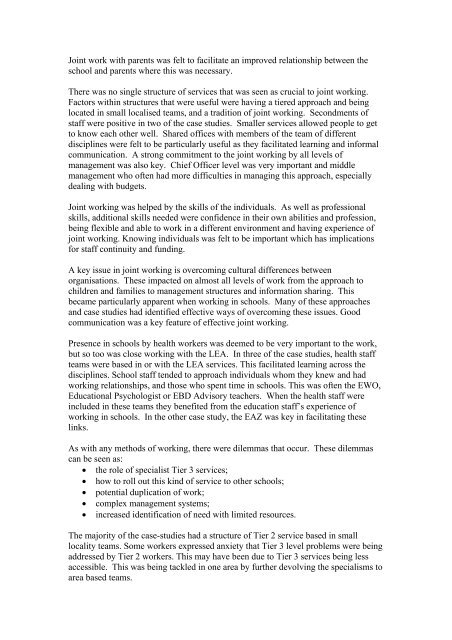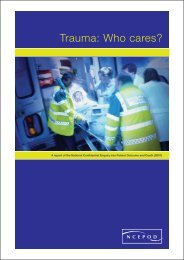(CAMHS) and Schools - London Health Programmes
(CAMHS) and Schools - London Health Programmes
(CAMHS) and Schools - London Health Programmes
You also want an ePaper? Increase the reach of your titles
YUMPU automatically turns print PDFs into web optimized ePapers that Google loves.
Joint work with parents was felt to facilitate an improved relationship between the<br />
school <strong>and</strong> parents where this was necessary.<br />
There was no single structure of services that was seen as crucial to joint working.<br />
Factors within structures that were useful were having a tiered approach <strong>and</strong> being<br />
located in small localised teams, <strong>and</strong> a tradition of joint working. Secondments of<br />
staff were positive in two of the case studies. Smaller services allowed people to get<br />
to know each other well. Shared offices with members of the team of different<br />
disciplines were felt to be particularly useful as they facilitated learning <strong>and</strong> informal<br />
communication. A strong commitment to the joint working by all levels of<br />
management was also key. Chief Officer level was very important <strong>and</strong> middle<br />
management who often had more difficulties in managing this approach, especially<br />
dealing with budgets.<br />
Joint working was helped by the skills of the individuals. As well as professional<br />
skills, additional skills needed were confidence in their own abilities <strong>and</strong> profession,<br />
being flexible <strong>and</strong> able to work in a different environment <strong>and</strong> having experience of<br />
joint working. Knowing individuals was felt to be important which has implications<br />
for staff continuity <strong>and</strong> funding.<br />
A key issue in joint working is overcoming cultural differences between<br />
organisations. These impacted on almost all levels of work from the approach to<br />
children <strong>and</strong> families to management structures <strong>and</strong> information sharing. This<br />
became particularly apparent when working in schools. Many of these approaches<br />
<strong>and</strong> case studies had identified effective ways of overcoming these issues. Good<br />
communication was a key feature of effective joint working.<br />
Presence in schools by health workers was deemed to be very important to the work,<br />
but so too was close working with the LEA. In three of the case studies, health staff<br />
teams were based in or with the LEA services. This facilitated learning across the<br />
disciplines. School staff tended to approach individuals whom they knew <strong>and</strong> had<br />
working relationships, <strong>and</strong> those who spent time in schools. This was often the EWO,<br />
Educational Psychologist or EBD Advisory teachers. When the health staff were<br />
included in these teams they benefited from the education staff’s experience of<br />
working in schools. In the other case study, the EAZ was key in facilitating these<br />
links.<br />
As with any methods of working, there were dilemmas that occur. These dilemmas<br />
can be seen as:<br />
• the role of specialist Tier 3 services;<br />
• how to roll out this kind of service to other schools;<br />
• potential duplication of work;<br />
• complex management systems;<br />
• increased identification of need with limited resources.<br />
The majority of the case-studies had a structure of Tier 2 service based in small<br />
locality teams. Some workers expressed anxiety that Tier 3 level problems were being<br />
addressed by Tier 2 workers. This may have been due to Tier 3 services being less<br />
accessible. This was being tackled in one area by further devolving the specialisms to<br />
area based teams.

















